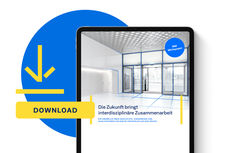We support you in door planning and implementation of comprehensive door solutions.
Door planning is a key aspect of construction that is often underestimated: implementing a standard-compliant, secure and functional building solution requires a professional and integrated approach to designing complex doors. GEZE offers architects, builders, general planners, contractors and project managers comprehensive, manufacturer-independent information and practical support to successfully master the challenges of door planning. Take advantage of our years of experience to optimally design your projects
Our services: Comprehensive door planning and solutions from a single source
Our experienced door planners support builders, architects and planners in their projects from the design phase until building operations are up and running. They provide professional, product-neutral support for the typical challenges of door planning, taking into account functional requirements such as building safety, fire protection, smoke protection, escape and rescue routes, accessibility and networking.
REQUEST A FREE CONSULTATION
The holistic planning of doors begins early on in the design phase and continues throughout the further planning and execution stages until the building operation is in a secure state.
Our core services: Comprehensive door planning and solutions from a single source
- Manufacturer-neutral advice
- Professional planning and standard-compliant execution
- Recording and categorisation of door function types and associated parameters
- Effective digital door planning with BIM
- Structural quality control and coordination of relevant interface trades
- Professionally qualified coordination of integral tests, commissioning and documented acceptance procedures
- Detailed documentation with expert operator and user training
Expert door planning is a complex task, and is inseparable from expert planning of other product groups. Such interfaces have to be defined early on.
Günther Weizenhöfer, architect, specialist planner for accessibilityIn addition to the required quality, cost certainty and adherence to deadlines play a central role in successful project implementation.
Because of this, we focus on the following areas:
- Product-neutral, manufacturer-independent design, planning and implementation of technically sound and compliant door and gate solutions for secure operational processes
- Early identification of critical requirements and targeted conflict resolution at important junctures
- Identifying potential savings and cost certainty through efficient planning, coordination and implementation
- Standard-compliant and functional design of door and gate solutions for durable systems and maximum operational safety
- Support in creating clear, neutral tenders based on specific descriptions of the doors in terms of construction, function and design
- Planning reliability through professional interface management in planning and execution, as well as quality assurance during construction for on-time project implementation
- Reliable contact for builders, specialist planners, subcontractors and site managers in all project phases
- Comprehensible database and documentation as needed for all parties involved (in planning, tendering, execution and building operation) through transparent, digital methodology in all phases
Contact us for professional support for your projects, from concept to successful implementation.
DOOR PLANNING INQUIRYFrequently asked questions about door planning
Door planning clarifies the purpose of doors, brings together all relevant planning participants and product groups in a coordinated manner, and ensures that different systems are integrated smoothly. Professional door planning ensures that the often numerous customer-specific and legal requirements for a door and the functions required for implementation are combined in a useful way and can be successfully implemented in the door design.
Good technical planning takes a holistic approach and considers building operations: How should the doors function, and what requirements must be met? Which users must be considered, which processes are necessary, and which scenarios must be included? The required quality, deadlines and cost factors must always be kept in mind and coordinated with relevant decision-makers.
Early project involvement is crucial: technical expertise, solution-oriented communication and coordinated interface management ensure successful door planning.
Proper door planning lays the foundation for a safe, functional and standard-compliant building. Professional door planning combines security requirements, aesthetics, functionality and legal requirements into a holistic overall concept. Early, comprehensive planning, and informative documents such as functional descriptions and complete door lists not only minimise legal risks, but also set the course for smooth implementation.
Doors often seem an inconspicuous part of the construction process, yet they are among the most critical interfaces in the entire building. If mistakes are made during planning, this can have serious consequences:
- Doors do not work as intended
- Critical requirements for security, fire protection or accessibility are not met
- Retrofitting causes high additional costs
- Construction processes are delayed due to a lack of coordination
- Operators and users face security risks and additional costs in everyday use
In short: if you don't plan doors carefully, you risk technical problems, legal conflicts and unnecessary costs.
To help you avoid these pitfalls, we have compiled a concise list of the most common mistakes encountered in practice – including tips on how to do better.
Determine basic principles
- Clarification of the specific task and scope of services
- Compilation of the formulated requirements regarding building law, use and design
- Basic identification of the required specialist planners and interfaces
- Definition of door parameters and assignment of responsibilities
Assess door system requirements
- Systematic listing of all requirements, closing information gaps
- Clarification of missing requirements and outstanding issues
- Approaches to resolving conflicting requirements
- Identification of basic function types in the planning documents
Define door functions and create door lists
- Definition of door function types and their variants based on differing requirements, design and features
- Creation of door function specifications with a description of all functional processes and a schematic representation of the necessary components and electrical supply lines
- Editing and checking the door list for consistency and completeness
Identify, define and coordinate interfaces
- Identification of relevant interfaces and product groups
- Definition and description of the respective performance priorities and performance limits
- Clarification of timelines, necessary preliminary work and responsibilities
Support tendering and assist with the awarding of door contracts
- Checking the quality and completeness of the service specifications
- Contact person for technical questions during the tender process
- Support in reviewing bids, advising on and evaluating bids in terms of service quality and overall economic efficiency
Support subcontractors in planning their work
- Review of feasibility and compliance with specifications
- Contact person for queries from subcontractors and site management
- Participation in planning the construction schedule and coordination of pre-commissioning inspections and assembly
Construction quality assurance – construction supervision
- Coordination of product groups and interfaces
- Conflict resolution
- Pre-commissioning inspection and participation in functional tests
- Carrying out expert construction supervision during assembly and acceptance
Property handover, briefing of operators and users
- Support during handover of property to the client
- Compilation and handover of complete documentation for functional doors
- Functional instruction of operator representatives Handling documentation to fulfil operator responsibilities
- Instruction of relevant user groups in the functionality and proper use of the functional doors
Door lists have become an established practice for door planning in large building projects. A door list comprises an organised list of the properties of all doors to be installed in a construction project. Door lists contain precise information for each individual door regarding its location, installation situation, geometry, material properties, design and required technical equipment. Door lists thus describe all essential characteristics and requirements that do not apply globally to all doors in a construction project, but rather vary from door to door. These include, in particular:
- Dimensions, including opening width, opening direction (left hand door or right hand door).
- Building regulations and user requirements such as sound proofing, escape route, burglary protection, radiation protection, climate class, thermal conductivity or fire protection classifications, as well as environmental product declarations (EPDs)
- Material, surfaces and the design of the door leaf and frame
- Details on lock and door hardware as well as additional components such as door closers, fire door holders or door automation
- Electrical components such as push buttons, electric strikes, sensors, devices for securing the emergency exit door, contacts and information on signal transmission
Door lists can be used to systematically record all features. But be careful: the door list alone does not say anything about the overall functionality and feasibility of the door in the building context. It is therefore important that architects, fire safety planners, electricians and other relevant specialist planners are involved in the planning process at an early stage to ensure that the planned door solutions can be integrated into the overall architecture and technical requirements of the building. The door list is related to other documents and primarily serves as a quantitative derivation of the door parameters, which can be checked for completeness, consistency and quality in this form using test rules. In most cases, a door list is not sufficient for complex door situations. The role of door function and description are often overlooked. This very quickly leads to inadequate, substandard execution.
The buildingSMART competence network has made a list of how many parameters a door can theoretically have. The organisation collected an impressive 4,500 parameters that cover all variants and combinations. In practice, planners do not describe all of these parameters in door lists, as the number and characteristics of the parameters must always be defined on a project-specific basis. Many architectural firms work with an office standard for basic parameters, their names and possible characteristics. For more complex construction projects and requirements, this must be defined in detail together with the door specialist at the start of the project. In BIM projects, this is recorded in a model element matrix, which describes all parameters to be used for all components. It is also important to determine which product group is responsible for which parameters.
Expert door planners have to do more than just take a wide range of different demands into account. The interactions between different demands, which can sometimes result in contradictions, also represents another challenge. An expert planner involved in the process at the right time can offer a comprehensive perspective, identify overlaps between functions, set the right priorities and coordinate the process with the product groups concerned.
One typical contradiction, for instance, are simultaneous demands for noise protection and accessibility. Sound proofing requires door leaves with a multi-layer structure and heavier core materials, as well as several sealing layers. As a result, such doors are often not barrier-free, as both opening and closing them requires considerable effort.
Another typical contradiction is that of SHEV inlet vents versus fire and smoke protection: while the smoke and heat extraction system opens the doors, fire and smoke protection requires closed doors.
Another typical example is the apparent contradiction between fire protection and accessibility.
You can find out more about this alleged contradiction between fire protection and accessibility in our video.
If a tender is based on untested door lists and the specified components are supplied, the following problem often arises: the manufacturer installs the door but does not take care of the cabling. The electrician lays the cables to the door but does not connect the cables to the door components as he does not have an order to do so. The product groups involved focus on specific tasks and often lack an overview of the overall door design. As a result, some doors remain incomplete and do not function as desired by the client.
The need for coordination between the various product groups is often underestimated. Doors that are not correctly installed can pose safety risks. This means that each individual function is tested, but not the overall function. For example, in the event of a fire, the door may close but cannot be opened as an emergency exit. Even a fire protection system designed to centrally control all doors in the event of danger could fail.
Extensive modifications or adjustments are often necessary to rectify such discrepancies later on. This usually leads to delays on the construction site, higher costs and potential loss of revenue. Therefore, professional door planning and coordination of all trades involved are crucial to the success of the project.
Effective door planning with BIM (Building Information Modelling)

Complex construction projects are cheaper and more efficient with BIM. © Getty Images/Westend61
Building Information Modeling (BIM) enables digital and interdisciplinary collaboration between all product groups involved in a digital building model. BIM-based door planning offers decisive advantages: all relevant door information, legal and user-specific requirements, and technical specifications are gradually created and iteratively adjusted in the building model throughout the planning process.
Changes are synchronised in real time throughout all project phases and are then visible to all parties involved. With digital door planning, all relevant door parameters are systematically recorded and customised solutions are created for your specific requirements. With the help of door function types (typicals) and our established approach, we use our BIM expertise to reduce your planning work and minimise the sources of error.
The advantages of planning with BIM:
- Automated evaluations: Precise door list derivations and detailed quantity calculations can be generated at any time
- Quality assurance: Rule-based checks enable early detection of conflicting requirements and ensure standard-compliant planning
- Comprehensive documentation: In addition to door lists, door function typicals are at the heart of door planning. These organise all the necessary information for a function type on a detailed sheet.
- Holistic approach: Our planning supports you from the planning stage right through to operation and takes into account the entire building life cycle
To get started with BIM-based door planning, GEZE has developed BIM objects based on the results of the buildingSMART door group. You can download these BIM objects free of charge and integrate them into your CAD system.

Free BIM white paper from GEZE
Learn more about building planning with BIM in our free white paper!
Download GEZE BIM white paper


